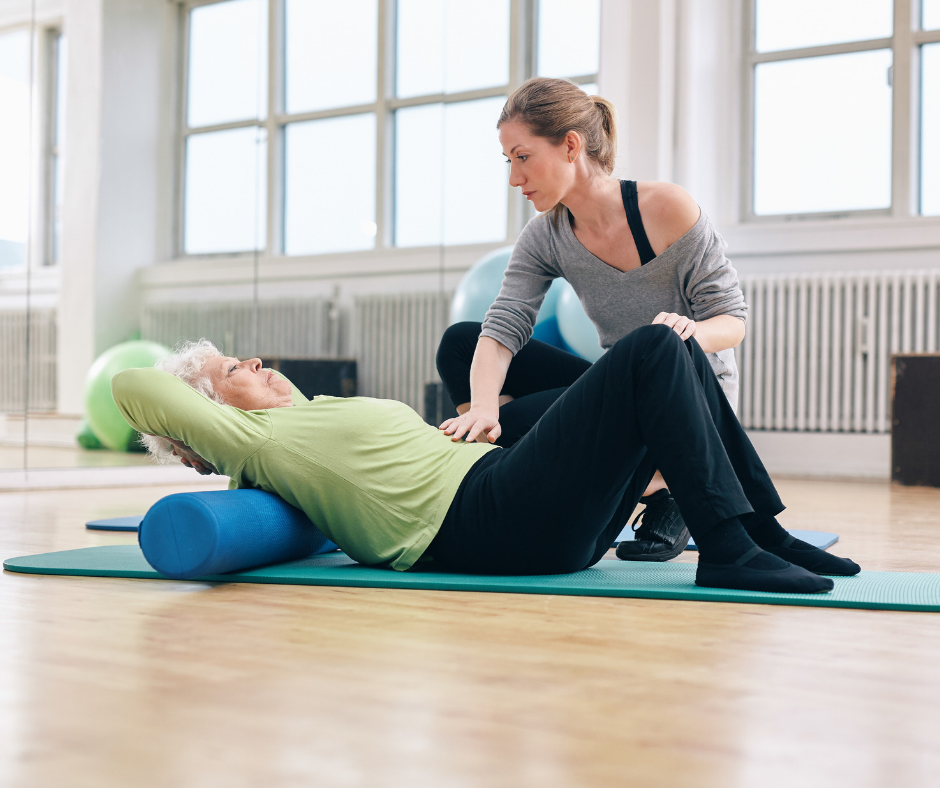It doesn’t matter your age. Many of us spend a lot of time looking down at our phones, and that’s causing problems. Specifically, text neck. This is a craned neck that can lead to other issues like discomfort, slouching, sleep issues, and more. Thankfully, corrective exercises can help with the discomfort caused by not only our devices but any activity that has us straining our neck.
But how does it happen, and why is it so bad?
First off, let’s take a look at the human head…
Why would tilting your head cause so much trouble? Well, the average human head weighs about 12-pounds, so it’s not exactly light. But there’s more to it.
The head’s weight depends on its angle and what muscles are holding it up. For example, at a 15-degree tilt, the human head goes from 12-pounds to 27-pounds. Or when you have a 30-degree tilt, you end up having a 40-pound head.
A 60-degree tilt — which is roughly where you’re at when you’re looking at your phone — makes a 12-pound head apply the same pressure as though it were 60-pounds. That’s like carrying 7 gallons of water on your head all of the time! We don’t realize it because we’re constantly doing it, but that’s a lot of stress on your muscles.
The National Library of Medicine found that — on average — most people under 30 spend 1,400 hours per year looking at their phones with that 60-percent tilt. That’s 60-pounds for 1,400 hours a year. Do you see why that might cause some issues?
Where exactly is the problem?
First off, this stress on the ligaments puts a lot of stress on the spine.
If you think about it, you’ve probably noticed some discomfort in your neck, shoulders, and upper back. Many people write it off as stress or tension, but most of it is probably due to a habit of looking down, usually at a smartphone.
It’s all about the ligaments…
Even if you do understand the issue, most people don’t think about what’s happening with the ligaments. They’re too focused on the spine, discs, and vertebrae. Though all of that is important, a lot of the discomfort can come from your ligaments.
If you were to take your finger and bend it back for a whole minute, you’d start to feel the tension in your ligaments. Well, think about text neck. You hold your head in one position for a prolonged period of time, distracted by your device or book, and don’t really notice the strain. But really, you’re stretching your ligaments and potentially creating issues with your vertebral discs.
But also your back…
The other thing you have to consider is the weakening of the shoulder blades. If you’re constantly looking down, it takes the tension off of the scapulae. This causes your scapulae and the muscles that retract them to weaken. By looking down at your phone, you put pressure on your neck, strengthening your neck muscles, but diminishing your shoulder blades. This is going to contribute to an anterior tilt, which we also don’t want.
This subsequently affects your back, impairing mobility by causing weakness and aches. The shoulder blades and back begin to stiffen, simply because the shoulders are rolling forward and those muscles aren’t doing the job of retracting anymore.
Your phone could give you a hunchback?!
You can run into a lot of problems when the ligaments that surround the spine are stretched. This could even lead to a deterioration that turns into joint issues, with them potentially freezing, fusing, or becoming brittle. Well, imagine if the ligaments were loose and then the spine froze in one position — then you’ve got a hunchback situation. We will likely see many of today’s youth dealing with hunchback issues when they’re in their fifties and sixties, possibly even sooner.
Then, of course, we have the facet joints. These little joints guide spinal movement. When you have deterioration of these joints, you’re going to feel stiff and sore. This is because the surrounding muscles must work extra hard to modify and compensate for your weakened spine. And that can then snowball into muscle tension issues.
You’re also putting pressure on your lungs…
Yep, looking down at your phone and causing all of these ligament, joint, and muscle issues can lead to a 30-percent reduction in lung capacity. When you’re looking down at your phone, you’re tucking in your chest and preventing your lungs from getting a full breath of air.
If you take a deep breath and find that it hurts, it might not be because of your lungs. Many people make the mistake of thinking they have a lung issue when this happens, but really the muscles in the rib cage could be too constricted to allow for proper mobility. As a result, it becomes difficult to properly expand and open the diaphragm.
So what are the fixes for text neck?
Here are a few things you can do:
The first is a chin tuck. This rebuilds the strength behind the neck. To do a chin tuck, stand in an upright position, take two fingers, put them on your chin, then push back. You should feel the push in your neck as it’s being gently straightened into its proper place. You don’t want to look down and you don’t want to look to the side. Look straight on so you’re retracting and pulling your head backwards. Do four sets of these for fifteen seconds daily.
Next, try shoulder pinches. The muscles that retract your shoulder blades could be getting weak and suffering as a result. To help this, retract your shoulder blades, pinch, hold for two seconds, and relax. Roll it back, pinch, hold for two seconds, and relax. Try to do this for a few minutes every day.
 Then take a look at foam rolling. You want to roll out your upper back whenever you have tension. This exercise loosens tight muscles and can even relieve discomfort. If you think your shoulder and back muscles are compromised due to text neck, this could help!
Then take a look at foam rolling. You want to roll out your upper back whenever you have tension. This exercise loosens tight muscles and can even relieve discomfort. If you think your shoulder and back muscles are compromised due to text neck, this could help!
You can purchase a foam roller or use something like a lacrosse ball against the wall. Roll out the shoulder blades as much as you can, then loosen your pectoral. If you think your shoulder blades may be weak or tense from text neck, use the roller to ease this area.
Lastly, make sure you’re getting the right nutrition. Your muscles need the proper tools to not only recover, but remain healthy. Here at Purality Health, our Micelle Liposomal Curcumin Gold (which also has ginger oil and DHA from algal oil) can help encourage a healthy inflammation response.
Plus, with our micelle liposomal technology, you get increased absorption!




